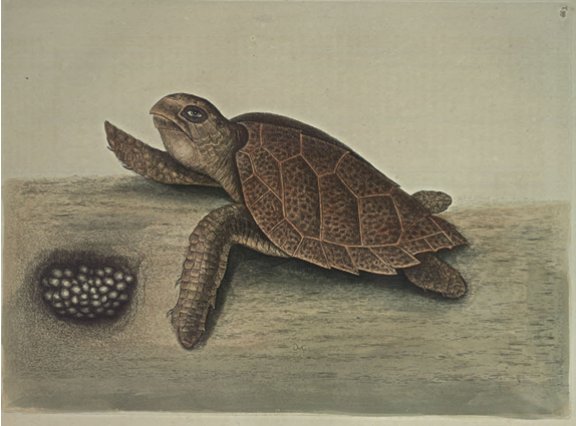Plate Number: II 39Of the Manner of taking Turtle Of the Manner of taking Turtle The Inhabitants of the Bahama-lslands by often Practice are very dextrous in catching them, particularly the Green Turtle. In April they go in little Boats to the Coasts of Cuba, - and other neighbouring Islands, where in the Evening, especially in Moon-light Nights they watch the going and returning of the Turtle, to and from their Nests, at which Time they turn them on their Backs, where they leave them, and proceed on turning all they meet, for they cannot get on their Feet again when once turn'd. Some are so large that it requires three Men to turn one of them. The Way by which Turtle are most commonly taken at the Bahama-Islands is by striking them with a small Iron Peg of two Inches long, this Peg is put in a Socket at the End of a Staff 12 Feet long. Two Men usually set out for this Work in a little light Boat or Canoe, one to row and gently steer the Boat, while the other hands at the Head of it with his Striker. The Turtle are sometimes discovered by their swimming with their Head and Back out of the Water, but they are oftenest discovered lying, at the Bottom, a Fathom or more deep. If the Turtle perceives he is discovered, he starts up to make his Escape, the Men in the Boat pursuing him, endeavour to keep Sight of him, which they often loose and recover again by the Turtle putting his Nose out of the Water to breathe; thus they pursue him, one palling or rowing, while the other hands ready with his Striker; it is sometimes half an Hour before he is tired; then he links at once to the Bottom, which gives them an Opportunity of striking him, which is by piercing the Shell of the Turtle through with the iron Peg, which flips out of the Socket, but is fastened by a String to the Pole. If he is spent and tired by being long pursued, he tamely submits when struck to be taken into the Boat or hauled a-Shoat. There are Men, who by diving will get on their Backs, and by pressing down their Hind-part, and raising the Fore-part of them by Force, bring them to the Top of the Water, while another slips a Noose about their Necks. Testudo Caretta: The Hawks-bill TurtleThis Kind of Turtle receives its Name from the Form of its Mouth, resembling that of an Hawk's beak; the upper Jaw hanging more over the under Jaw than in the other Kinds. As the green Turtle is most valued far the Food it affords, this is next in Esteem for the usefulness of its Shell, so well known in Mechanick Uses. The Strength and Beauty of the Shell is sufficient dent to distinguish it from the other Kinds of Turtle, besides, their Head and Neck extended is longer than in others; the Hind-part of the Shell is narrower, and indented with sharp-pointed Notches; the Fore Legs are longer than in any of the other Kinds. These Turtle are said to feed most on a Sea Fungus, by the Inhabitants called Jews-ears. |